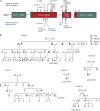PRRT2 gene mutations: from paroxysmal dyskinesia to episodic ataxia and hemiplegic migraine
- PMID: 23077024
- PMCID: PMC3511930
- DOI: 10.1212/WNL.0b013e3182752c5a
PRRT2 gene mutations: from paroxysmal dyskinesia to episodic ataxia and hemiplegic migraine
Abstract
Objective: The proline-rich transmembrane protein (PRRT2) gene was recently identified using exome sequencing as the cause of autosomal dominant paroxysmal kinesigenic dyskinesia (PKD) with or without infantile convulsions (IC) (PKD/IC syndrome). Episodic neurologic disorders, such as epilepsy, migraine, and paroxysmal movement disorders, often coexist and are thought to have a shared channel-related etiology. To investigate further the frequency, spectrum, and phenotype of PRRT2 mutations, we analyzed this gene in 3 large series of episodic neurologic disorders with PKD/IC, episodic ataxia (EA), and hemiplegic migraine (HM).
Methods: The PRRT2 gene was sequenced in 58 family probands/sporadic individuals with PKD/IC, 182 with EA, 128 with HM, and 475 UK and 96 Asian controls.
Results: PRRT2 genetic mutations were identified in 28 out of 58 individuals with PKD/IC (48%), 1/182 individuals with EA, and 1/128 individuals with HM. A number of loss-of-function and coding missense mutations were identified; the most common mutation found was the p.R217Pfs*8 insertion. Males were more frequently affected than females (ratio 52:32). There was a high proportion of PRRT2 mutations found in families and sporadic cases with PKD associated with migraine or HM (10 out of 28). One family had EA with HM and another large family had typical HM alone.
Conclusions: This work expands the phenotype of mutations in the PRRT2 gene to include the frequent occurrence of migraine and HM with PKD/IC, and the association of mutations with EA and HM and with familial HM alone. We have also extended the PRRT2 mutation type and frequency in PKD and other episodic neurologic disorders.
Figures

Comment in
-
Paroxysmal disorders associated with PRRT2 mutations shake up expectations on ion channel genes.Neurology. 2012 Nov 20;79(21):2086-8. doi: 10.1212/WNL.0b013e3182752edd. Epub 2012 Oct 17. Neurology. 2012. PMID: 23077020 No abstract available.
-
Genetics: expanding the spectrum of neurological disorders associated with PRRT2 mutations.Nat Rev Neurol. 2012 Dec;8(12):657. doi: 10.1038/nrneurol.2012.240. Epub 2012 Nov 20. Nat Rev Neurol. 2012. PMID: 23165339 No abstract available.
Similar articles
-
PRRT2 links infantile convulsions and paroxysmal dyskinesia with migraine.Neurology. 2012 Nov 20;79(21):2097-103. doi: 10.1212/WNL.0b013e3182752c46. Epub 2012 Oct 17. Neurology. 2012. PMID: 23077017 Free PMC article.
-
The clinical and genetic heterogeneity of paroxysmal dyskinesias.Brain. 2015 Dec;138(Pt 12):3567-80. doi: 10.1093/brain/awv310. Epub 2015 Nov 23. Brain. 2015. PMID: 26598494 Free PMC article. Review.
-
PRRT2 mutations cause hemiplegic migraine.Neurology. 2012 Nov 20;79(21):2122-4. doi: 10.1212/WNL.0b013e3182752cb8. Epub 2012 Oct 17. Neurology. 2012. PMID: 23077016
-
Phenotypes and PRRT2 mutations in Chinese families with benign familial infantile epilepsy and infantile convulsions with paroxysmal choreoathetosis.BMC Neurol. 2013 Dec 26;13:209. doi: 10.1186/1471-2377-13-209. BMC Neurol. 2013. PMID: 24370076 Free PMC article.
-
PRRT2-related disorders: further PKD and ICCA cases and review of the literature.J Neurol. 2013 May;260(5):1234-44. doi: 10.1007/s00415-012-6777-y. Epub 2013 Jan 9. J Neurol. 2013. PMID: 23299620 Review.
Cited by
-
Paroxysmal Genetic Movement Disorders and Epilepsy.Front Neurol. 2021 Mar 23;12:648031. doi: 10.3389/fneur.2021.648031. eCollection 2021. Front Neurol. 2021. PMID: 33833732 Free PMC article. Review.
-
Age-dependent neurological phenotypes in a mouse model of PRRT2-related diseases.Neurogenetics. 2021 Jul;22(3):171-185. doi: 10.1007/s10048-021-00645-6. Epub 2021 Jun 8. Neurogenetics. 2021. PMID: 34101060 Free PMC article.
-
Treatment of paroxysmal dyskinesias in children.Curr Treat Options Neurol. 2015 Jun;17(6):350. doi: 10.1007/s11940-015-0350-9. Curr Treat Options Neurol. 2015. PMID: 25864940
-
Genetics of migraine: where are we now?J Headache Pain. 2023 Feb 20;24(1):12. doi: 10.1186/s10194-023-01547-8. J Headache Pain. 2023. PMID: 36800925 Free PMC article. Review.
-
Clinical features of patients with paroxysmal kinesigenic dyskinesia, mutation screening of PRRT2 and the effects of morning draughts of oxcarbazepine.BMC Pediatr. 2019 Nov 14;19(1):439. doi: 10.1186/s12887-019-1798-7. BMC Pediatr. 2019. PMID: 31722684 Free PMC article.
References
-
- Kure S. Atypical Thomsen's disease. Tokyo Igakukai Zasshi 1892;6:505–514
-
- Gowers WR. Epilepsy and Other Chronic Convulsive Diseases: Their Causes, Symptoms, and Treatment, 2nd ed. London: J. & A. Churchill; 1901:75–76
-
- Kertesz A. Paroxysmal kinesigenic choreoathetosis: an entity within the paroxysmal choreoathetosis syndrome: description of 10 cases, including 1 autopsied. Neurology 1967;17:680–690 - PubMed
-
- Weber MB. Familial paroxysmal dystonia. J Nerv Ment Dis 1967;145:221–226 - PubMed
-
- Bhatia KP. Paroxysmal dyskinesias. Mov Disord 2011;26:1157–1165 - PubMed
Publication types
MeSH terms
Substances
Grants and funding
- G0802158/MRC_/Medical Research Council/United Kingdom
- G0801316/MRC_/Medical Research Council/United Kingdom
- G108/638/MRC_/Medical Research Council/United Kingdom
- 089698/Wellcome Trust/United Kingdom
- MC_G1000735/MRC_/Medical Research Council/United Kingdom
- 095580/Wellcome Trust/United Kingdom
- G116/147/MRC_/Medical Research Council/United Kingdom
- G0802760/MRC_/Medical Research Council/United Kingdom
- G1001253/MRC_/Medical Research Council/United Kingdom
- G0200373/MRC_/Medical Research Council/United Kingdom
- MC_G0901330/MRC_/Medical Research Council/United Kingdom
- MC_PC_09003/MRC_/Medical Research Council/United Kingdom
- 084655/Wellcome Trust/United Kingdom
LinkOut - more resources
Full Text Sources
Medical
